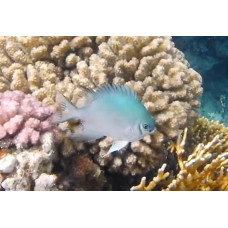Latin name
Amblyglyphidodon leucogaster
Other name
Amblyglyphidodon leucogaster
Identification
This species is distinguished by the following characters: D XII-XIII,12-13 (usually XIII,12); A II,12-14 (often II,13); thoracic rays 16-17; lateral line of tubular scales 14-17; total number of gill blades 25-29; body depth 1.5-1.8 inches.
Features of fish fins
Dorsal spines (total): 13; Dorsal soft rays (total): 12 - 13; Anal spines: 2; Anal soft rays: 12 - 14.
Fish colouring
The coloration of these fish is silvery gray with lighter central scales and a yellow belly. The anterior half of the anal fin and the anterior edge of the soft dorsal fin, as well as the upper and lower edges of the caudal fin are blackish. The base of the upper pectoral fin has a distinct black wedge-shaped mark.
Distribution
Widespread in the tropical waters of the Indo-West Pacific: from the eastern Indian Ocean; north to Ryukyu Island; south to Indonesia, including Western Australia, to the Caroline and Marshall Islands.
Habitat
A marine tropical species. Adults inhabit lagoons, reef passages and outer reef slopes. Depth ranges from 2 to 45 meters.
Size
It is a small fish that can reach a maximum length of 13 centimeters.
Behavior
Yellowbelly damselfish are solitary or in small groups. They do not migrate.
Food and feeding habits
They feed on paddlefish, amphipods, clams, fish eggs, crustacean larvae and small amounts of algae.
Reproduction
Egg-laying, mating during reproduction. Eggs are on the bottom and attached to the substrate. Males guard and aerate eggs.
Fishing
This species has little commercial value. They are sometimes caught for sale to aquariums.
Relationship with a person
Harmless.
| Classification | |
| Phylum | Chordata |
| Class | Actinopterygii |
| Family | Pomacentridae |
| Genus | Amblyglyphidodon |
| Species | A. leucogaster |
| Features | |
| Conservation status | Least Concern |
| Habitat | Pelagic |
| Life span, years | No information |
| Maximum body weight, kg | No information |
| Maximum length, cm | 13 |
| Sailing speed, m/s | No information |
| Threat to people | Not edible |
| Way of eating | Planktonophage |
Yellowbelly damselfish
Tags: yellowbelly damselfish



